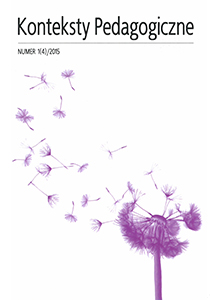Abstract
Because I represent interactional theory of creativity, and I want to explore and talk about creativity (in the full sense of the word) personality traits are taken into account, the creative process, the properties of creative work and lifestyle. When I take into account only one of the aspects I talk about subjective creativity. For these reasons, this text focuses on the verbal subjective creativity of students class I–III, which is an integral sphere of their lives. They create their own language, as soon as they hear what others say to him or her. In natural situations, verbal subjective creativity of the child can be seen in two ways: as a creative language learning and as its creative use. In the first case emphasizes that the child ran onto a language not just by imitation. In the process of learn-ing a language student creates it at the same time, so the overlap are two ways of acquiring it: creation and imitation. Mastering the language and using it in social situations and cognition are inseparable from creative activity. Language is a tool for a child with which the child communicates with the environment, material for artistic activity and object recognition. The more variety of situations requiring the usage of language encounters the child, the more you have the op-portunity to shape in the belief that language is a very variable, flexible „creation” which gives many opportunities to express the same content in a different way.
References
Andrukowicz W., Wokół fenomenu i istoty twórczości, Toruń 1999.
Dobrołowicz J., Kreatywność uczniów a ich osiągnięcia szkolne, Kielce 2002.
Dobrołowicz W., Psychodydaktyka kreatywności, Warszawa 1995.
Erikson E.H., Tożsamość a cykle życia, Poznań 2004.
Gloton R., Clero C., Twórcza aktywność dziecka, przeł. I. Wojnar, Warszawa 1985.
Góralski A., Zadanie, metoda, rozwiązanie, Warszawa 1978.
Guilford J.P., Natura inteligencji człowieka, przeł. B. Czarniawska, W. Kozłowski, J. Ra-dzicki, Warszawa 1978. Kielar M., Mowa dziecka. Słowo i tekst, Kraków 1989.
Kłosińska T., Droga do twórczości: wdrażanie technik Celestyna Freineta, Kraków 2000.
Kozielecki J., Transgresja i kultura, Warszawa 1998.
Kujawiński J., Twórczość metodyczna nauczyciela, Poznań 2001.
Magda-Adamowicz M., Obraz twórczych pedagogicznie nauczycieli klas początkowych, Toruń 2012.
Magda-Adamowicz M., Treningi twórczości a umiejętności zawodowe, Toruń 2011.
Magda-Adamowicz M., Uwarunkowania efektywności kształcenia nauczycieli klas I–III w zakresie twórczości pedagogicznej, Zielona Góra 2009.
Magda-Adamowicz M., Wizerunek twórczego pedagogicznie nauczyciela klas I–III, Zie-lona Góra 2007.
Mały słownik języka polskiego, red. M. Szymczak, Warszawa 1982.
Nęcka E., Psychologia twórczości, Gdańsk 2001.
Popek S., Człowiek jako istota twórcza, Lublin 2003.
Popek S., Psychologia twórczości plastycznej, Kraków 2010.
Przetacznik-Gierowska M., Psychologia rozwojowa i wychowawcza wieku dziecięcego, Warszawa 1986.
Słownik współczesnego języka polskiego, red. B. Dunaj, Warszawa 1996.
Strzałecki A., Psychologia twórczości: między tradycją a ponowoczesnością,Warszawa 2003.
Suchodolski B., Kim jest człowiek?,Warszawa 1985.
Szmidt K.J., Pedagogika twórczości, Gdańsk 2007.
Szymański M., Twórczość i style poznawcze uczniów, Warszawa 1987.
Tatarkiewicz W., Dzieje sześciu pojęć, Warszawa 1982
In accordance with the recommendation of the Ministry of Science and Higher Education, which aims to counteract the practice of “ghostwriting” and “guest authorship,” all authors submitting their text for publication should attach an author’s statement which declares the contribution of each of the authors to the article. The printed and signed statement should be delivered by mail or other means to editor-in-chief Joanna Skibska or sent in the form of a scan to the following e-mail address: redakcja@kontekstypedagogczne.pl. The authors will not receive remuneration for publishing their papers. The editors reserve the right to make minor editorial changes to the articles which will not affect the substance of the article. We encourage all authors to prepare their articles in accordance with the guidelines for manuscript preparation. Download pdf file.
Authors transfer all copyrights and grant the journal the right of first publication with the work simultaneously licensed under a Creative Commons Attribution License that allows others to share the work with acknowledgement of the work's authorship and initial publication in this journal. All authors agree to the publishing of their email addresses, affiliations and short bio statements with their articles during the submission process.

